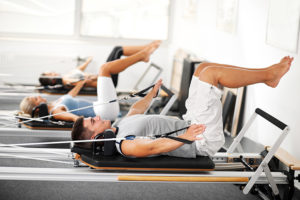by Michelle Sutton-Kerchner
Know how to recover from a workout. Hint: It does not involve binge-watching …
It takes more than a heart-pounding workout with plenty of sweat to get in shape. Sure, that covers the basics. However, the sophisticated exerciser knows (and everyone eventually learns) success requires some nurturing.
Here are the rules for fitness engagement—and disengagement.
Work Hard
 You’ve probably already got this. Give it your all on the Fitness Floor or in the studio or pool. Max out your reps, weights, and duration. Accomplish the healthy exhaustion happily associated with a well-done workout.
You’ve probably already got this. Give it your all on the Fitness Floor or in the studio or pool. Max out your reps, weights, and duration. Accomplish the healthy exhaustion happily associated with a well-done workout.
Long after you stop exercising though, your body continues to perform. Tender muscles and minor stiffness indicate you are working hard behind-the-scenes to deliver sculpted muscles and increased stamina (for future, now you may feel like flopping down on the couch). Help make fitness happen with active recovery days.
Rest Well
The most effective fitness programs include recovery days. Give your body the opportunity to capitalize on all the good stuff you prompted during your workout. On these days, avoid intense physical activity. This allows repair of the muscles and tissues that were broken down during exercise.

Some interpret an easy day as laziness (go hard or go home!). Others hit the couch with an assumed guilt-free reason to watch endless TV shows. Both are incorrect. A recovery day should consist of healthy activities, with emphasis beyond a sweat session. Think of it as a holistic approach to getting in shape, whether through a walk in the park or time spent journaling.
- Change the Focus
If you’re addicted to strength training, alternate upper- and lower-body workouts on different days of the week. This type of recovery workout should focus on a different muscle group than the previous day’s session. Or, focus on full-body exercises rather than concentrating efforts on one area.
Both options prevent over-training specific muscles, which are busy trying to recover from previous efforts. Both options allow you to advance resistance training while minimizing risk of injury and maximizing effectiveness. Plus, you get your fitness fix.
- Go Easy
Plan a day of lighter exercises. Downgrade reps and weight limits. (For recovery days, experts recommend weights at 30 percent of your heaviest weight ability. Ask a trainer for guidance.) If you don’t want to miss the camaraderie of fitness class, ask your instructor to share modifications. Maintain the routine (and keep up with the latest from your buddies) without overdoing it.
Feeling wimpy exercising below your capacity? Think of those who define “recovery day” as a chance to channel surf. That comparison will make your light workout feel more acceptable. You rock!
- Experiment

Recovery days are ideal for trying new activities, which likely will require different thought processes and muscle groups than usually engaged. Suggestions for these low-impact sessions:
Pilates
Yoga
Hiking
T’ai Chi
Jogging
Cycling at a leisurely pace
Walking at a moderate pace
Core exercises varied from your usual
These workouts should not require more than 60 percent of your maximum effort. To keep this in check, continuously focus on feeling healthy, energized, and self-aware. Monitor form; take time to perfect movements.
- Go for a Swim

Water workouts deliver a twofer on recovery days. The water’s buoyancy minimizes joint stress, naturally facilitating more fluid movements and stretches. And, the pressure of the water itself improves circulation, which helps nourish muscles and cells as they rebuild. If aquatics is your usual workout, try spending your recovery day doing a gentle land routine.
- Sleep
Sleep replenishes the physical and mental energy needed for your workout and daily life. Poor sleep habits affect your ability to exercise as well as your ability to recuperate from it. While you sleep, the body busily repairs muscle wear-and-tear, allowing your fitness efforts to yield a stronger, healthier result. Sleep is healing—whether recovering from an injury, a stressful day, or a HIIT workout. Your body deserves an adequate amount.
Practice Recovery
 Active recovery days build fitness momentum while giving your body a rest from intense workouts. Mentally, you stay on track with your health journey (rather than replacing workout time with, say, a donut break). Physically, you accelerate the body’s repair process. Increased circulation efficiently delivers nutrients to recovering muscles and tissues, and helps rid the body of waste. Light exercise also improves flexibility and loosens tight muscles left from your last sweat session.
Active recovery days build fitness momentum while giving your body a rest from intense workouts. Mentally, you stay on track with your health journey (rather than replacing workout time with, say, a donut break). Physically, you accelerate the body’s repair process. Increased circulation efficiently delivers nutrients to recovering muscles and tissues, and helps rid the body of waste. Light exercise also improves flexibility and loosens tight muscles left from your last sweat session.
Make recovery days standard in your exercise program. Include enough activity to enhance your fitness efforts—and a bit of Netflix to take care of the rest.
Sources
“The 6 Best Ways to Recover from Your Workout,” by Jon-Erik Kawamoto at mensjournal.com.
“11 of the Best Activities to Do on Active Recovery Days,” by Lauren Bedosky at self.com.
 Fitness & Wellness News Your Source for Fitness News, Wellness News, Health News, and Nutrition News!
Fitness & Wellness News Your Source for Fitness News, Wellness News, Health News, and Nutrition News!




